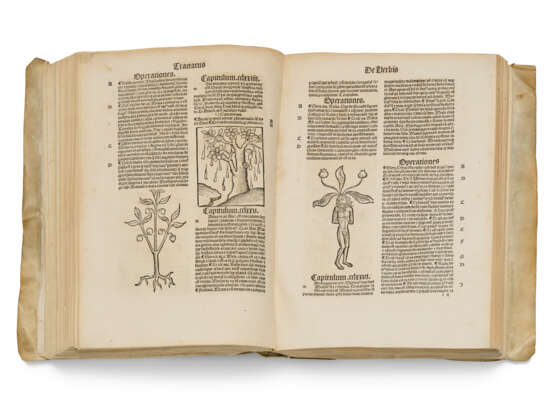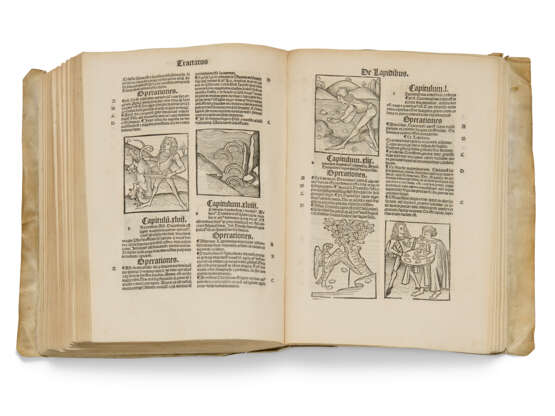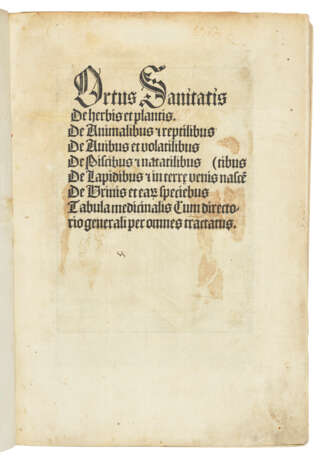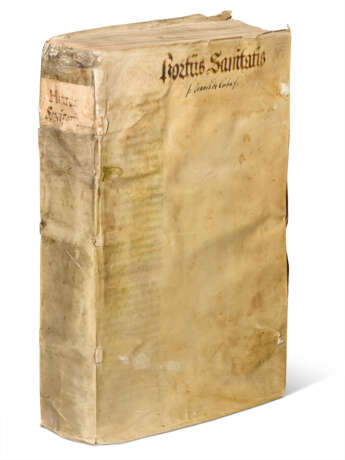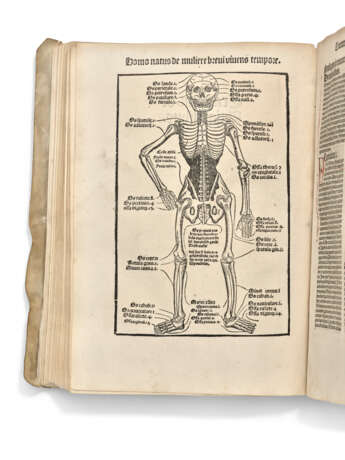ID 1449881
Lot 64 | Hortus sanitatis [Strasbourg: Johann Prüss, not after 21 Oct...
Estimate value
£ 40 000 – 60 000
First Strasbourg edition of ‘perhaps the most important medical book printed before 1500’ (Hunt) and the ‘most important natural historical work of the Middle Ages’ (Choulant). The Hortus sanitatis is an illustrated natural history encyclopaedia, comprising treatises on plants, animals, birds, fish and precious stones and minerals with a specific focus on their medical application, along with a treatise on urine. First printed by Meydenbach in Mainz in 1491, it succeeded Peter Schöffer's 1485 Gart der Gesundheit to stand as the last great medieval compendium of natural history. The text is a significantly expanded Latin version of the Gart, restructured for ease of practical use, and while the copious woodcuts are copied in part from Schöffer's edition, many new designs have been added to the supplementary sections, increasing the number to over 1,000. In addition to plants and animals – from the lowly (worms, snails, frogs) to the fantastic (mandrakes, unicorns, merpeople) – the woodcuts contain many scenes of medieval life and craft. The chapters on plants feature a physical description of the plant and its synonyms, notes on its geographical origins, and a list of its medicinal applications; those on animals, birds, fish, stones and minerals include a fuller discussion of their use in medicine than feature in its vernacular predecessor, and the treatise on urology has been expanded. The woodcuts from Meydenbach's edition, which are imitated here, were copied throughout Europe for nearly a century, in a variety of publications.
All three of Johann Prüss's editions of the Hortus sanitatis are undated. This edition, the first of the three, was printed no later than 21 October 1497: the Harvard Arnold Arboretum copy has a note of acquisition bearing this date. Most of the plant woodcuts were previously used in the Gart der Gesundheit, while the majority of the remaining cuts are either direct or reverse copies of the Meydenbach cuts, some slightly reduced or with added background or different costumes for the human figures, and with additional single-line borders to the cuts in the second part. The three large woodcuts were first used in Grüninger's edition of Hieronymus Brunschwig's Chirurgia (4 July 1497). The present edition of the Hortus sanitatis is the first to include the woodcut of the human skeleton; it was reproduced in later editions of the herbal and remained, ‘from a graphic viewpoint the best that was published... before Vesalius’ (Klebs). BMC I 124; BSB-Ink H-389; CIBN H-295; GW 13550; Goff H487; Klebs 509.3; ISTC ih00487000.
Chancery folio (300 x 210mm). 360 leaves, 55 lines and head-line, double column. Type: 300G, 210G, 146G, 80G. 3- to 8-line initial spaces with printed guide-letters, some initial letters supplied in red in a 16th-century German hand, three full-page woodcuts (two of these heightened with ochre and brown) and over 1,000 column-width woodcuts (i1.6 rehinged, a small split to hinge of A8, a few expert repairs to fore-edges and a couple of imperfections left unrepaired, occasional faint water-staining or thumb-soiling in margin, some browning most obvious to title). Contemporary vellum, old paper label (fragments of ties preserved, upper portion of spine replaced, a little creased and rubbed, staining and splitting to endleaves and flyleaves). Provenance: Initial letters, sometimes flourished, and marginal indexing added in red in a 16th-century German hand to the treatise on plants.
| Place of origin: | Western Europe, Germany, Europe |
|---|---|
| Auction house category: | Antiquarian books, Medicine & science, Books and manuscripts, Printed books |
| Place of origin: | Western Europe, Germany, Europe |
|---|---|
| Auction house category: | Antiquarian books, Medicine & science, Books and manuscripts, Printed books |
| Address of auction |
CHRISTIE'S 8 King Street, St. James's SW1Y 6QT London United Kingdom | |
|---|---|---|
| Preview |
| |
| Phone | +44 (0)20 7839 9060 | |
| Buyer Premium | see on Website | |
| Conditions of purchase | Conditions of purchase |
